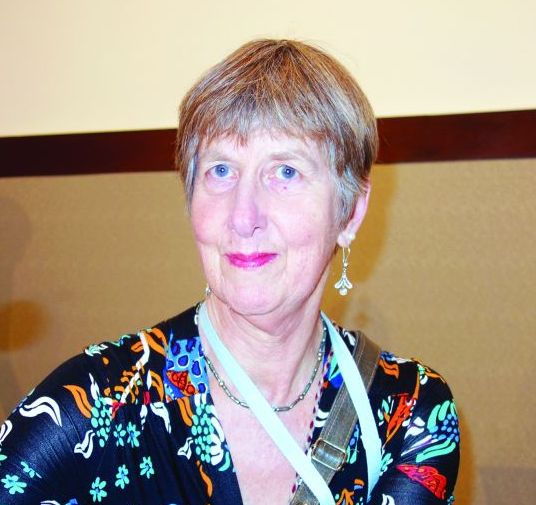User login
BOSTON – A randomized trial in sub-Saharan Africa found no evidence that first-line raltegravir (Isentress)triggers immune reconstitution syndrome in HIV patients.
It’s an important finding because raltegravir and other integrase inhibitors are replacing nonnucleoside reverse-transcriptase inhibitors (NNRTIs) as first-line treatments for HIV. There have been a few reports from observational studies that among severely immunocompromised, the rapid drop in viral load (VL) with the drugs might trigger immune reconstitution syndrome (IRIS), an exaggerated, dysfunctional, and sometimes fatal response to pathogens as the immune system begins to recover.
The 1,805 subjects in those four countries – a few children, but mostly adults – started the trial with median baseline CD4 counts of 37 cells/mcL and VLs of 249,770 copies/mL; 903 were randomized to standard treatment with two nucleoside reverse transcriptase inhibitors plus one NNRTI (Efavirenz), while 902 were randomized to the same regimen but with raltegravir during the first 12 weeks.
As expected, VLs came down very fast in the raltegravir group to a mean of only 80 copies/mL at 4 weeks, vs. a mean of 480 copies/mL in the standard treatment arm.
After a median of about a month, 225 fatal and 113 nonfatal IRIS events (adjudicated by a review committee blinded to randomization) occurred in 9.9% of patients in the raltegravir arm and 9.5% of patients on standard treatment, a nonsignificant difference (P = .79). IRIS was fatal in 4% of raltegravir patients and 3.4% of standard-care patients, also a nonsignificant difference (P = .54).
In both groups, TB-IRIS occurred in about 6%, cryptococcal-IRIS in about 2%, and IRIS of unknown etiology in about 2%. Also in both groups, IRIS risk was highest among older subjects as well as those who went into treatment with particularly low CD4 counts or tuberculosis (TB).
“Basically, the increase in IRIS was not there. We believe these results can be extrapolated across the class of integrase inhibitors. This provides great reassurance,” especially given the prospect of first-line integrase inhibitors in developing countries, where patients tend to present with more advanced disease, said lead investigator Diana Gibb, MD, an epidemiology professor and researcher at the University College London at the Conference on Retroviruses and Opportunistic Infections.
The wrinkle in the findings was that “we didn’t see any benefit to adding raltegravir to the first 12 weeks of treatment. Everyone thought that by [driving] down the viral load faster, you might get less disease progression, and so fewer deaths. We didn’t see any difference at all. The mortality was identical at 24 weeks [around 10.5% in both arms] and at 48 weeks [around 12.5%]. The same if you looked at” severe AIDS complications, she said.
Fast, steep declines in VL “might not necessarily translate” to clinical benefit, Dr. Gibb said.
What did make a difference was IRIS prophylaxis.
The study included a second randomization at baseline, 906 subjects were randomized to enhanced prophylaxis with isoniazid, fluconazole, azithromycin, trimethoprim-sulfamethoxazole, and single-dose albendazole (Albenza); 899 others were randomized to standard prophylaxis with trimethoprim-sulfamethoxazole alone (N Engl J Med. 2017 Jul 20;377[3]:233-45).
Enhanced prophylaxis nearly halved the incidence of IRIS from 12% to 7.4%, and significantly reduced deaths at 48 weeks from 14.4% to 11% (P = .04).
“Patients with very low CD4 counts and high viral loads are the patients where this enhanced protocol package would be useful,” Dr. Gibb said.
The median age in the trial was 36 years; 4% of the subjects were 5-17 years old. Just over half the subjects were male.
The work was supported by the U.K. Department for International Development, the Wellcome Trust, and others. Dr. Gibb didn’t have any disclosures.
aotto@frontlinemedcom.com
SOURCE: Gibb D et al. CROI, Abstract 23.
BOSTON – A randomized trial in sub-Saharan Africa found no evidence that first-line raltegravir (Isentress)triggers immune reconstitution syndrome in HIV patients.
It’s an important finding because raltegravir and other integrase inhibitors are replacing nonnucleoside reverse-transcriptase inhibitors (NNRTIs) as first-line treatments for HIV. There have been a few reports from observational studies that among severely immunocompromised, the rapid drop in viral load (VL) with the drugs might trigger immune reconstitution syndrome (IRIS), an exaggerated, dysfunctional, and sometimes fatal response to pathogens as the immune system begins to recover.
The 1,805 subjects in those four countries – a few children, but mostly adults – started the trial with median baseline CD4 counts of 37 cells/mcL and VLs of 249,770 copies/mL; 903 were randomized to standard treatment with two nucleoside reverse transcriptase inhibitors plus one NNRTI (Efavirenz), while 902 were randomized to the same regimen but with raltegravir during the first 12 weeks.
As expected, VLs came down very fast in the raltegravir group to a mean of only 80 copies/mL at 4 weeks, vs. a mean of 480 copies/mL in the standard treatment arm.
After a median of about a month, 225 fatal and 113 nonfatal IRIS events (adjudicated by a review committee blinded to randomization) occurred in 9.9% of patients in the raltegravir arm and 9.5% of patients on standard treatment, a nonsignificant difference (P = .79). IRIS was fatal in 4% of raltegravir patients and 3.4% of standard-care patients, also a nonsignificant difference (P = .54).
In both groups, TB-IRIS occurred in about 6%, cryptococcal-IRIS in about 2%, and IRIS of unknown etiology in about 2%. Also in both groups, IRIS risk was highest among older subjects as well as those who went into treatment with particularly low CD4 counts or tuberculosis (TB).
“Basically, the increase in IRIS was not there. We believe these results can be extrapolated across the class of integrase inhibitors. This provides great reassurance,” especially given the prospect of first-line integrase inhibitors in developing countries, where patients tend to present with more advanced disease, said lead investigator Diana Gibb, MD, an epidemiology professor and researcher at the University College London at the Conference on Retroviruses and Opportunistic Infections.
The wrinkle in the findings was that “we didn’t see any benefit to adding raltegravir to the first 12 weeks of treatment. Everyone thought that by [driving] down the viral load faster, you might get less disease progression, and so fewer deaths. We didn’t see any difference at all. The mortality was identical at 24 weeks [around 10.5% in both arms] and at 48 weeks [around 12.5%]. The same if you looked at” severe AIDS complications, she said.
Fast, steep declines in VL “might not necessarily translate” to clinical benefit, Dr. Gibb said.
What did make a difference was IRIS prophylaxis.
The study included a second randomization at baseline, 906 subjects were randomized to enhanced prophylaxis with isoniazid, fluconazole, azithromycin, trimethoprim-sulfamethoxazole, and single-dose albendazole (Albenza); 899 others were randomized to standard prophylaxis with trimethoprim-sulfamethoxazole alone (N Engl J Med. 2017 Jul 20;377[3]:233-45).
Enhanced prophylaxis nearly halved the incidence of IRIS from 12% to 7.4%, and significantly reduced deaths at 48 weeks from 14.4% to 11% (P = .04).
“Patients with very low CD4 counts and high viral loads are the patients where this enhanced protocol package would be useful,” Dr. Gibb said.
The median age in the trial was 36 years; 4% of the subjects were 5-17 years old. Just over half the subjects were male.
The work was supported by the U.K. Department for International Development, the Wellcome Trust, and others. Dr. Gibb didn’t have any disclosures.
aotto@frontlinemedcom.com
SOURCE: Gibb D et al. CROI, Abstract 23.
BOSTON – A randomized trial in sub-Saharan Africa found no evidence that first-line raltegravir (Isentress)triggers immune reconstitution syndrome in HIV patients.
It’s an important finding because raltegravir and other integrase inhibitors are replacing nonnucleoside reverse-transcriptase inhibitors (NNRTIs) as first-line treatments for HIV. There have been a few reports from observational studies that among severely immunocompromised, the rapid drop in viral load (VL) with the drugs might trigger immune reconstitution syndrome (IRIS), an exaggerated, dysfunctional, and sometimes fatal response to pathogens as the immune system begins to recover.
The 1,805 subjects in those four countries – a few children, but mostly adults – started the trial with median baseline CD4 counts of 37 cells/mcL and VLs of 249,770 copies/mL; 903 were randomized to standard treatment with two nucleoside reverse transcriptase inhibitors plus one NNRTI (Efavirenz), while 902 were randomized to the same regimen but with raltegravir during the first 12 weeks.
As expected, VLs came down very fast in the raltegravir group to a mean of only 80 copies/mL at 4 weeks, vs. a mean of 480 copies/mL in the standard treatment arm.
After a median of about a month, 225 fatal and 113 nonfatal IRIS events (adjudicated by a review committee blinded to randomization) occurred in 9.9% of patients in the raltegravir arm and 9.5% of patients on standard treatment, a nonsignificant difference (P = .79). IRIS was fatal in 4% of raltegravir patients and 3.4% of standard-care patients, also a nonsignificant difference (P = .54).
In both groups, TB-IRIS occurred in about 6%, cryptococcal-IRIS in about 2%, and IRIS of unknown etiology in about 2%. Also in both groups, IRIS risk was highest among older subjects as well as those who went into treatment with particularly low CD4 counts or tuberculosis (TB).
“Basically, the increase in IRIS was not there. We believe these results can be extrapolated across the class of integrase inhibitors. This provides great reassurance,” especially given the prospect of first-line integrase inhibitors in developing countries, where patients tend to present with more advanced disease, said lead investigator Diana Gibb, MD, an epidemiology professor and researcher at the University College London at the Conference on Retroviruses and Opportunistic Infections.
The wrinkle in the findings was that “we didn’t see any benefit to adding raltegravir to the first 12 weeks of treatment. Everyone thought that by [driving] down the viral load faster, you might get less disease progression, and so fewer deaths. We didn’t see any difference at all. The mortality was identical at 24 weeks [around 10.5% in both arms] and at 48 weeks [around 12.5%]. The same if you looked at” severe AIDS complications, she said.
Fast, steep declines in VL “might not necessarily translate” to clinical benefit, Dr. Gibb said.
What did make a difference was IRIS prophylaxis.
The study included a second randomization at baseline, 906 subjects were randomized to enhanced prophylaxis with isoniazid, fluconazole, azithromycin, trimethoprim-sulfamethoxazole, and single-dose albendazole (Albenza); 899 others were randomized to standard prophylaxis with trimethoprim-sulfamethoxazole alone (N Engl J Med. 2017 Jul 20;377[3]:233-45).
Enhanced prophylaxis nearly halved the incidence of IRIS from 12% to 7.4%, and significantly reduced deaths at 48 weeks from 14.4% to 11% (P = .04).
“Patients with very low CD4 counts and high viral loads are the patients where this enhanced protocol package would be useful,” Dr. Gibb said.
The median age in the trial was 36 years; 4% of the subjects were 5-17 years old. Just over half the subjects were male.
The work was supported by the U.K. Department for International Development, the Wellcome Trust, and others. Dr. Gibb didn’t have any disclosures.
aotto@frontlinemedcom.com
SOURCE: Gibb D et al. CROI, Abstract 23.
REPORTING FROM CROI
Key clinical point: Amid concern to the contrary, integrase inhibitors might not trigger IRIS in the severely immunocompromised.
Major finding: IRIS events – 225 fatal and 113 nonfatal – occurred in 9.9% of patients in the raltegravir arm and 9.5% of patients on standard treatment (P = .79).
Study details: Randomized trial with 1,805 subjects
Disclosures: The work was supported by the U.K. Department for International Development, the Wellcome Trust, and others. The lead investigator had no disclosures.
Source: Gibb D et al. CROI, Abstract 23.

